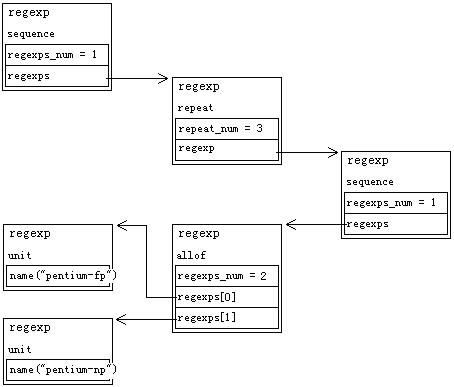GCC's bacl-end & assemble emission (20)
来源:互联网 发布:如何查看淘宝排名 编辑:程序博客网 时间:2024/04/30 11:03
9.3.11. Readin DEFINE_RESERVATION pattern
Section 8.1.3Overview of DEFINE_INSN_RESERVATION pattern describes the detail of DEFINE_RESERVATION pattern. For this patternwe use following example:
129 (define_reservation "pentium-firstuvboth""(pentium-load + pentium-firstuv inpentium.md
130 + pentium-memory)
131 |(pentium-firstv,pentium-v,
132 (pentium-load+pentium-firstv))")
This pattern is part of pipe hazards description for construtingDFA-based recognizer, this pattern shouldn’t coexist with define_function_unitin same machine description file.
After treated by init_md_reader_args,above pattern will be loaded into memory as rtx object as following.

figure 47 : example of DEFINE_RESERVATION pattern
Obviously, this primitive form isn’t what we want. gen_reservgenerates more organized ones.
2106 void
2107 gen_reserv (rtx def) ingenautomata.c
2108 {
2109 decl_t decl;
2110
2111 decl = create_node (sizeof(struct decl));
2112 decl->mode = dm_reserv;
2113 decl->pos = 0;
2114 DECL_RESERV (decl)->name = check_name ((char *) XSTR (def, 0),decl->pos);
2115 DECL_RESERV (decl)->regexp = gen_regexp ((char *) XSTR (def, 1));
2116 VLA_PTR_ADD (decls, decl);
2117 num_dfa_decls++;
2118 }
DECL_RESERV accesses reserv field of decl.
845 struct reserv_decl ingenautomata.c
846 {
847 char *name;
848 regexp_t regexp;
849
850 /* The following fields are defined bychecker. */
851
852 /* The following field value is nonzero ifthe unit is used in an
853 regexp. */
854 char reserv_is_used;
855 /* The following field is used to check upcycle in expression
856 definition. */
857 int loop_pass_num;
858 };
regexp is designed for regular expression describing the occupation of cpuunits for certain instructions. Refer to 8.1.3 Overview of DEFINE_INSN_RESERVATIONpattern for detail of the regularexpression.
990 struct regexp ingenautomata.c
991 {
992 /* What node in theunion? */
993 enum regexp_mode mode;
994 pos_t pos;
995 union
996 {
997 structunit_regexp unit;
998 structreserv_regexp reserv;
999 structnothing_regexp nothing;
1000 structsequence_regexp sequence;
1001 structrepeat_regexp repeat;
1002 structallof_regexp allof;
1003 struct oneof_regexponeof;
1004 } regexp;
1005 };
197 typedef struct regexp *regexp_t; ingenautomata.c
This structure is generated by gen_regexp. The regular expression obeysfollowing sytanx:
regexp = regexp "," oneof
| oneof
oneof = oneof"|" allof
| allof
allof = allof"+" repeat
| repeat
repeat = element"*" number
| element
element = cpu_function_unit_name
| reservation_name
| result_name
| "nothing"
| "(" regexp")"
gen_regexp forms the regexp object from the expression string in above figure.
2094 static regexp_t
2095 gen_regexp (char *str) ingenautomata.c
2096 {
2097 reserv_str = str;
2098 return gen_regexp_sequence (str);;
2099 }
gen_regexp generates the structure by parsing the expression from top-down. Forour example, the expression is "(pentium-load + pentium-firstuv +pentium-memory) | (pentium-firstv, pentium-v, (pentium-load + pentium-firstv))".
2069 static regexp_t
2070 gen_regexp_sequence (char *str) ingenautomata.c
2071 {
2072 regexp_t sequence;
2073 char **sequence_vect;
2074 int els_num;
2075 int i;
2076
2077 sequence_vect = get_str_vect (str,&els_num, ',', TRUE);
2078 if (els_num > 1)
2079 {
2080 sequence = create_node (sizeof (structregexp)
2081 + sizeof(regexp_t) * (els_num - 1));
2082 sequence->mode = rm_sequence;
2083 REGEXP_SEQUENCE(sequence)->regexps_num = els_num;
2084 for (i = 0; i < els_num; i++)
2085 REGEXP_SEQUENCE (sequence)->regexps[i]
2086 = gen_regexp_oneof (sequence_vect [i]);
2087 returnsequence;
2088 }
2089 else
2090 return gen_regexp_oneof (str);
In regular expression `,' is used for indicating the start of thenext cycle in the units reservation. At line 2077, get_str_vect tries toseparate the regular expression into cycles. Notice that the third parameter ofthe funciton is TRUE, the separation will be done only the left and right parenthesesare balanced. At both sides of “,” maybe the expression of “|”, so gen_regexp_oneofis invoked to handle both sides.
2043 static regexp_t
2044 gen_regexp_oneof (char *str) ingenautomata.c
2045 {
2046 regexp_t oneof;
2047 char **oneof_vect;
2048 int els_num;
2049 int i;
2050
2051 oneof_vect = get_str_vect (str, &els_num,'|', TRUE);
2052 if (oneof_vect == NULL)
2053 fatal ("invalid `%s' in reservation`%s'", str, reserv_str);
2054 if (els_num > 1)
2055 {
2056 oneof = create_node (sizeof (struct regexp)
2057 + sizeof (regexp_t) *(els_num - 1));
2058 oneof->mode = rm_oneof;
2059 REGEXP_ONEOF (oneof)->regexps_num =els_num;
2060 for (i = 0; i < els_num; i++)
2061 REGEXP_ONEOF (oneof)->regexps [i] = gen_regexp_allof (oneof_vect [i]);
2062 returnoneof;
2063 }
2064 else
2065 return gen_regexp_allof (str);
2066 }
This time get_str_vect tries to split the string by ‘|’.Again the third parameter of get_str_vect is TRUE, so for our example, wecan get oneof_vectat line 2051 with two elements:
"(pentium-load + pentium-firstuv + pentium-memory)"
"(pentium-firstv, pentium-v, (pentium-load + pentium-firstv))"
The second one can’t be split by get_str_vect with “,” because no “,” can be seenwhen “(“ balances “)”.
Above at line 2059, macro REGEXP_ONEOF accesses oneof field of regexp, whichhas definition as following, in which regexps field is a variable array, the size of itdepends on the number of operants of “|” (see line 2056 above).
983 struct oneof_regexp ingenautomata.c
984 {
985 int regexps_num;
986 regexp_t regexps [1];
987 };
Inside expression of “|”, we may encounter expression of “+”, so weneed gen_regexp_allofto handle the separated fragments.
2017 static regexp_t
2018 gen_regexp_allof (char *str) ingenautomata.c
2019 {
2020 regexp_t allof;
2021 char **allof_vect;
2022 int els_num;
2023 int i;
2024
2025 allof_vect = get_str_vect (str, &els_num,'+', TRUE);
2026 if (allof_vect == NULL)
2027 fatal ("invalid `%s' in reservation`%s'", str, reserv_str);
2028 if (els_num > 1)
2029 {
2030 allof = create_node (sizeof (structregexp)
2031 + sizeof(regexp_t) * (els_num - 1));
2032 allof->mode = rm_allof;
2033 REGEXP_ALLOF (allof)->regexps_num = els_num;
2034 for (i = 0; i < els_num; i++)
2035 REGEXP_ALLOF (allof)->regexps [i] = gen_regexp_repeat (allof_vect [i]);
2036 returnallof;
2037 }
2038 else
2039 return gen_regexp_repeat (str);
2040 }
get_str_vect at line 2025 now tries to find out the parts joined by ‘+’, againthe third parameter of it is TRUE, balanced parentheses is wanted.
Now for our example, the regular expression had been split into twoparts. For both parts, get_str_vect failsto do furthersplit. Both them enter gen_regexp_repeat at line 2039.
1984 static regexp_t
1985 gen_regexp_repeat (char *str) ingenautomata.c
1986 {
1987 regexp_t regexp;
1988 regexp_t repeat;
1989 char **repeat_vect;
1990 int els_num;
1991 int i;
1992
1993 repeat_vect = get_str_vect (str,&els_num, '*', TRUE);
1994 if (repeat_vect == NULL)
1995 fatal ("invalid `%s' in reservation`%s'", str, reserv_str);
1996 if(els_num > 1)
1997 {
1998 regexp = gen_regexp_el (repeat_vect [0]);
1999 for (i = 1; i < els_num; i++)
2000 {
2001 repeat = create_node (sizeof (struct regexp));
2002 repeat->mode= rm_repeat;
2003 REGEXP_REPEAT (repeat)->regexp = regexp;
2004 REGEXP_REPEAT (repeat)->repeat_num = atoi(repeat_vect [i]);
2005 if (REGEXP_REPEAT (repeat)->repeat_num<= 1)
2006 fatal ("repetition `%s' <= 1 in reservation `%s'",
2007 str, reserv_str);
2008 regexp = repeat;
2009 }
2010 returnregexp;
2011 }
2012 else
2013 return gen_regexp_el (str);
2014 }
Remember that `*' is used for convenience and simply means asequence in which the regular expression are repeated NUMBER times with cycleadvancing. For example, *5 means repeating for 5 times. In our example, bothparts don’t contain ‘*’, they just enter gen_regexp_el at line 2013.
1955 static regexp_t
1956 gen_regexp_el (char *str) ingenautomata.c
1957 {
1958 regexp_t regexp;
1959 int len;
1960
1961 if (*str == '(')
1962 {
1963 len = strlen (str);
1964 if (str [len - 1] != ')')
1965 fatal ("garbage after ) inreservation `%s'", reserv_str);
1966 str [len - 1] = '/0';
1967 regexp = gen_regexp_sequence (str + 1);
1968 }
1969 else if (strcmp (str, NOTHING_NAME) == 0)
1970 {
1971 regexp = create_node (sizeof (structdecl));
1972 regexp->mode = rm_nothing;
1973 }
1974 else
1975 {
1976 regexp = create_node (sizeof (structdecl));
1977 regexp->mode = rm_unit;
1978 REGEXP_UNIT (regexp)->name = str;
1979 }
1980 returnregexp;
1981 }
For our example, both two parts are enclosed by parentheses withinwhich should be regarded as a sequence. So gen_regexp_sequence will be recursed at line1967. In the end the example is transformed to following structure.

figure 48 : example of regexp object generated for define_ reservationpattern
9.3.12. Read inDEFINE_INSN_RESERVATION pattern
Section 8.1.3Overview of DEFINE_INSN_RESERVATION pattern describes the detail of DEFINE_INSN_RESERVATION pattern. For thispattern, we use following example.
166 (define_insn_reservation"pent_fpmovxf" 3 in pentium.md
167 (and (eq_attr "cpu" "pentium")
168 (and (eq_attr "type" "fmov")
169 (and (eq_attr "memory""load,store")
170 (eq_attr"mode" "XF"))))
171 "(pentium-fp+pentium-np)*3")
This pattern is part of pipe hazards description for construtingDFA-based recognizer, this pattern shouldn’t coexist with define_function_unitin same machine description file. As we have discussed in 9.3.5 Read DEFINE_FUNCTION_UNITpattern, this pattern describes system from the view-point of instructionsinstead of the view-point of function units. Commonly, number of instructionsis much larger than the number of units, so automaton is the better form forthe pipeline hazard recognizer.
After treated by init_md_reader_args, above pattern will beloaded into memory as rtx object as following.

figure 148 : example of DEFINE_INSN_RESERVATION pattern
This rtx object is not eligible for constructing DFA-based pipelinehazards recognizer. gen_insn_reserv isinvoked to pack up the data.
2125 void
2126 gen_insn_reserv (rtx def) ingenautomata.c
2127 {
2128 decl_t decl;
2129
2130 decl = create_node (sizeof(struct decl));
2131 decl->mode= dm_insn_reserv;
2132 decl->pos = 0;
2133 DECL_INSN_RESERV (decl)->name
2134 = check_name ((char *) XSTR (def, 0),decl->pos);
2135 DECL_INSN_RESERV (decl)->default_latency =XINT (def, 1);
2136 DECL_INSN_RESERV (decl)->condexp = XEXP (def,2);
2137 DECL_INSN_RESERV (decl)->regexp = gen_regexp((char *) XSTR (def, 3));
2138 VLA_PTR_ADD (decls, decl);
2139 num_dfa_decls++;
2140 }
Macro DECL_INSN_RESERV accesses insn_reserv field of decl, which has definitionas following.
861 struct insn_reserv_decl ingenautomata.c
862 {
863 rtx condexp;
864 int default_latency;
865 regexp_t regexp;
866 char *name;
867
868 /* The following fields are defined bychecker. */
869
870 /* The following field value is order number(0, 1, ...) of given
871 insn. */
872 int insn_num;
873 /* The following field value is list ofbypasses in which given insn
874 is output insn. */
875 struct bypass_decl*bypass_list;
876
877 /* The following fields are defined by automatongenerator. */
878
879 /* The following field is the insn regexptransformed that
880 the regexp has not optional regexp,repetition regexp, and an
881 reservation name (i.e. reservationidentifiers are changed by the
882 corresponding regexp) and all alternationsare the topest level
883 of the regexp. The value can be NULL onlyif it is special
884 insn `cycle advancing'. */
885 regexp_t transformed_regexp;
886 /* The following field value is list of arcsmarked given
887 insn. The field is used in transformationNDFA -> DFA. */
888 arc_t arcs_marked_by_insn;
889 /* The two following fields are used duringminimization of a finite state
890 automaton. */
891 /* The field value is number of equivalenceclass of state into
892 which arc marked by given insn enters froma state (fixed during
893 an automaton minimization). */
894 int equiv_class_num;
895 /* The field value is state_alts of arcleaving a state (fixed
896 during an automaton minimization) andmarked by given insn
897 enters. */
898 int state_alts;
899 /* The following member value is the list toautomata which can be
900 changed by the insn issue. */
901 automata_list_el_t important_automata_list;
902 /* The following member is used to processinsn once for output. */
903 int processed_p;
904 };
In gen_insn_reserv,at line 2138 the parameter of gen_regexp is "(pentium-fp+pentium-np)*3".This part after handled by gen_regexp producing following data.

figure 50 : example of regexp generated for define_insn_reservationpattern
- GCC's bacl-end & assemble emission (20)
- GCC's bacl-end & assemble emission (1)
- GCC's bacl-end & assemble emission (2)
- GCC's bacl-end & assemble emission (3)
- GCC's bacl-end & assemble emission (4)
- GCC's bacl-end & assemble emission (5)
- GCC's bacl-end & assemble emission (6)
- GCC's bacl-end & assemble emission (7)
- GCC's bacl-end & assemble emission (8)
- GCC's bacl-end & assemble emission (9)
- GCC's bacl-end & assemble emission (10)
- GCC's bacl-end & assemble emission (11)
- GCC's bacl-end & assemble emission (12)
- GCC's bacl-end & assemble emission (13)
- GCC's bacl-end & assemble emission (14)
- GCC's bacl-end & assemble emission (15)
- GCC's bacl-end & assemble emission (16)
- GCC's bacl-end & assemble emission (17)
- au3和tcp
- Vista/server2008引导修复(转载)
- struts2项目中用Js获取URL地址参数
- GCC后端及汇编发布(20)
- css相关
- GCC's bacl-end & assemble emission (20)
- GCC后端及汇编发布(21)
- GCC's bacl-end & assemble emission (21)
- 歌词
- 如何增加私有MIB
- asp.net 防止外部提交数据
- 菜单相关
- WebBrowser 缓存技术
- struts2-select标签


